





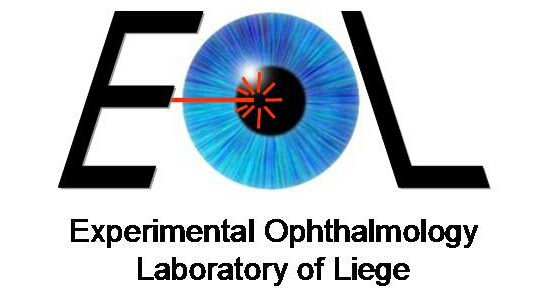
|
University of Liège, Pathology Tower (BC-3), Sart-Tilman, B-4000 Liège, BELGIUM Phone : +32-4-366.72.75 Fax : +32-4-366.29.36 |
To have a better understanding of Age-related Macular Degeneration also called AMD and to provide new perspectives in its treatment and prevention, we conduct studies on the molecular mechanisms involved in the development of choroidal neovascularization.
Age-related macular degeneration is the leading cause of visual loss in people over 70 years old in the western world. The pathogenesis of the disease is complex and fairly understood. The macula is the region of the retina which is responsible of the central vision and responsible of the details vision. This disease is a high handicap for the daylife. People affected have only the peripherical vision and see only shadows in the central vision. These persons can't read, look at the television or simply can't see growing up their grand children.
Exsudative form of AMD is characterized by the disruption of the normal anatomy of the complex formed by the Retinal Pigmented Epithelium (RPE) and the Bruch's membrane. New vessels arise from the choroid into the subretinal space. These vessels are fenestrated and bleeding which is very toxic for the retina. Indeed, these bleedings lead to fibrosis with a photoreceptors loss.
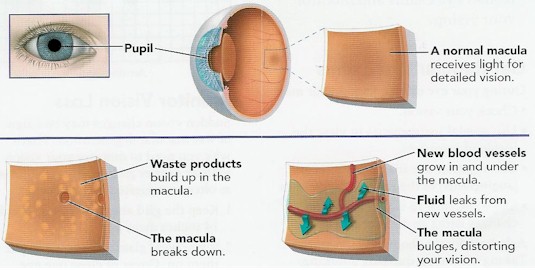
Pathological angiogenesis is the underlying cause of the exsudative form of AMD. The molecular signals involved in its initiation and progression are only partly defined.
Angiogenesis is an invasive process. This process requires proteolysis or digestion and remodelling of the extracellular matrix (ECM), proliferation and migration of the capillaries.
Such migratory and tissue remodeling events are not only regulated by VEGF but also by different proteolytic systems including matrix metalloproteinases and serine proteinases of the plasminogen/plasmin activator system. We are focusing on these proteolyic systems. Because, the molecular signals involved in the initiation of choroidal neovascularization and its progression are only partly defined.
These two proteolytic system are involved in a concerted manner.
Plasminogen is converted into plasmin by 2 plasminogen activators, uPA and tPA.
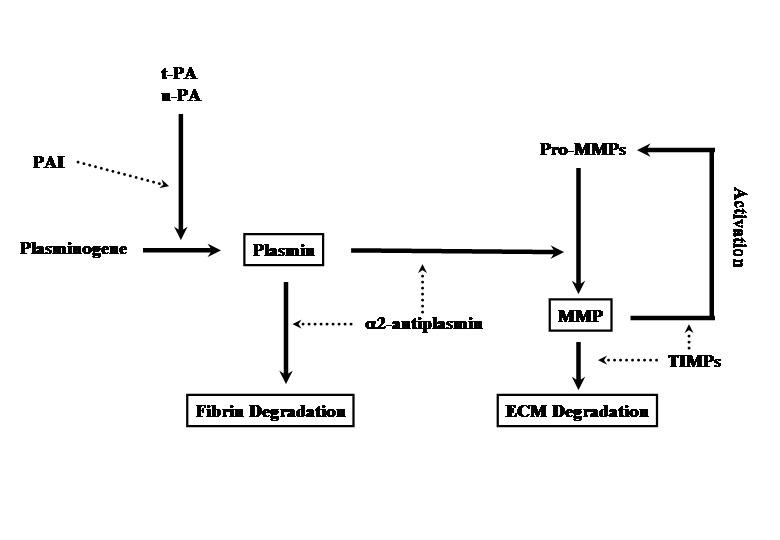
The activity of these plasminogen activators is controlled by Plasminogen activator inhibitor type-1 or PAI-1.
Plasmin plays a key role during extra cellular membrane remodelling since it can directly degrade ECM components,
And also indirectly activate other proteases: the MMPs
Among the MMPs, MMP-9 or gel B plays an important role in tissue remodelling.
1) The plasminogen/plasmin activator system:
To evaluate the biological relevance of this two systems in the sub-retinal angiogenesis, we use a murine model of laser induced choroidal neovascularization, on mice with a deficiency of one fundamental gene compared to control wild-type mice. The laser induces trauma at the level of outer retina, retinal pigmented epithelium and Bruch's membrane. It giving rise to sub-retinal neovascularization observable by fluorescein angiogram similar to patients with Age related Macular Degeneration.

Our observations pointed out the essential role of PAI-1, an important gene of the plasminogen/plasmin system, in the sub-retinal neovascularization and contribute to explain the multifunctional role of PAI-1 in the angiogenesis.
Unexpectidely, PAI-1, the inhibitor of Plasminogen activators appears essential in choroidal angiogenesis. In addition, for the first time, we have demonstrated a dose-dependent effect of PAI-1 in in vivo angiogenesis. There is a pro angiogenic effect of PAI-1 at low concentrations while at very high concentrations, PAI-1 has an anti angiogenic action. The existence of this biphasic dose/response curves provides an explanation to the controversial data reported in the literature, and warns against uncontrolled pharmacological strategies in which PAI-1 agonist and/or antagonists are used for the treatment of AMD.
2) The matrix metalloproteinases:
The matrix metalloproteinases also called MMPs participate in the tissue remodelling and are implicated in a huge panel of physiological and pathological events, such as tumoral invasion, wound healing and angiogenesis.
MMP-2 and MMP-9 are of particular interest because its substrate specificity includes type IV collagen, a basal membrane component wich have to be degraded to facilitate the migration of vascular endothelial cells. Pro-MMP-9 is activated by plasmin.
By using choroidal neovascular membranes surgically removed from patients suffering from AMD. We have observed a strong expression of MMP-2 and MMP-9 on these samples, suggesting a role of MMP-2 and MMP-9 in AMD.
To evaluate more precisely the spatial and temporal pattern of mRNA expression.
We have applied RT-PCR analysis on experimental neovascular membranes microdissected by laser pressure catapulting at different time endpoints.
Upregulation of mRNA expression is evident in WT mice at all time endpoints studied.
In contrast, retinal specimens microdissected from neighbouring intact chorioretinal areas remain negative.
These observations performed in the murine model are consistent with the results obtained with human specimens.
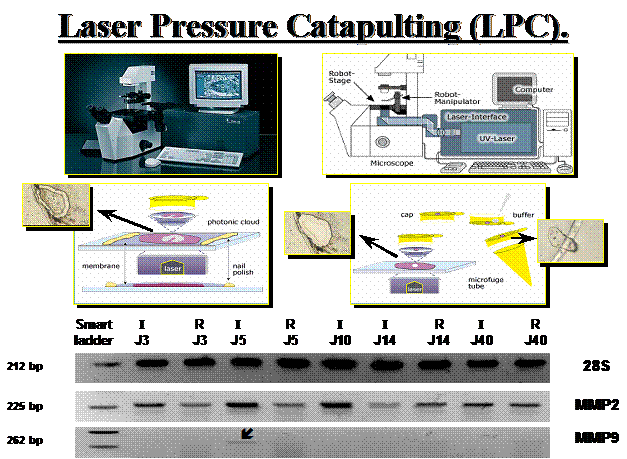
We have applied our experimental model to two types of MMPs KO mice: the MMP-2 and the MMP-9 deficient mice.
Choroidal pathological angiogenesis was nearly fully prevented in MMP-2/MMP-9 double deficient mice, while it was only partly impaired in the single MMP-2 or MMP-9 deficient mice. Is there a place for MMP inhibition in the treatment of choroidal neovascularization? This could be the case since we observed a severe inhibition of choroidal angiogenesis in mice treated with a selective gelatinase synthetic inhibitor. This selective inhibitor, called Ro 28-2653, reduces the choroidal neovascularization more effectively than a non specific inhibitor, called BB-94. This study could lead the development of new strategies in the treatment of the AMD.
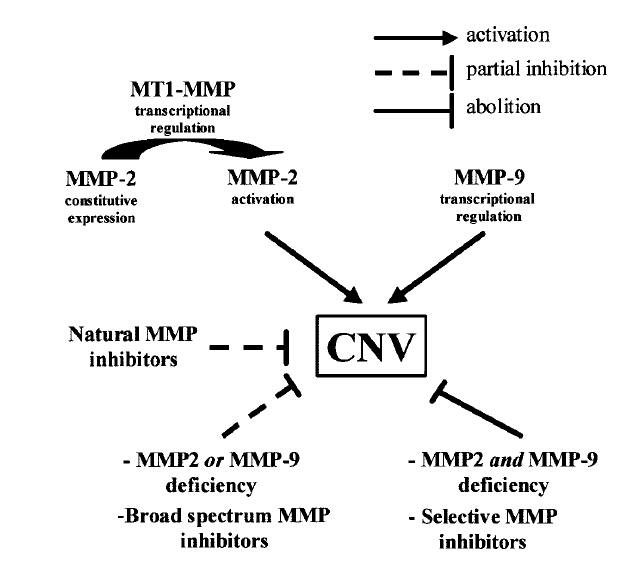
In conclusion, our work provides the demonstration of key role played by some proteases such as serine and metalloproteases and their inhibitors such as PAI-1 during AMD. These differents aspects of our study lead to new perspectives in therapeutical developments and in the improvement of the quality of life of older people. The results of this work warned against uncontrolled inhibition of PAI-1 in the treatment of the AMD. The specific inhibition of the proteases is hopeful for the curative treatment of the Age related macular degeneration. All together, these investigations could improve the efficiency of actual therapy for exsudative age-related macular degeneration.
Our aim is now to give further insight into the mechanism of proteases action into the development of CNV and determine biological targets to developped new therapeutic strategies.